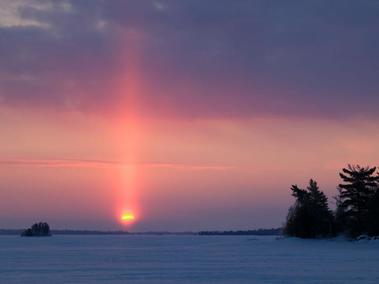
My interest in environmental music originated simply from a love of the outdoors and many hiking and camping excursions. However, it grew into something more important; a sort of documentation of our precious wilderness. Our climate is changing at an alarming rate. In fact, Minnesota is the second most-affected state in the U.S. (after Alaska) by climate change. And along with a changing climate, the land and its inhabitants are also quite visibly affected, driving efforts to document and preserve as much as possible. It occurred to me that our environment as it currently exists ought to be documented through art as well. While my music most certainly reflects the serenity and wonder of the wilderness experience, it also recognizes the fragile relationship that we all share and need to sustain.
Describe the research you did prior to composing earth sleeps below.
Last year I wrote a large work for the Minnesota Percussion Trio entitled Land of Cloud-Tinted Water that explored the diversity of various wilderness areas throughout Minnesota. In preparation for that work, I visited numerous state parks and nature preserves throughout the state to collect field recordings; study their landscapes, inhabitants, geography, history, etc; and simply to experience each place. Voyageurs National Park was one of those places, and I visited several times, both during summer and winter. The summertime experience was ultimately featured in Land of Cloud-Tinted Water, but I was captivated by the winter landscape there and wanted to explore it further. I went back for another visit last February while I was in the process of composing earth sleeps below.
earth sleeps below confines itself to a single harmonic world but explores a wide range within this world. Does this relate to Voyageurs National Park? If so, how?
Voyageurs consists of a vast area of interconnected lakes. Through earth sleeps below, I imagined the music beginning at surface level on one such lake, and panning out to discover the multitude of surrounding waterways, all connected and flowing as one.
Zeitgeist is also performing your work Black. Would you talk about how nature is reflected in that piece as well?
Black (2013) depicts a walk through the dense forests of the Minnesota Northwoods in the dead of night, emphasizing that with the absence of light (and light pollution from cities) we have a heightened sense of hearing, and with that, a heightened imagination for what might be lurking around. Surrounded by complete darkness, the sounds of the forest are magnified and the mystery of the wilderness intensified.

Zeitgeist & Spitting Image Collective
Details
Teaming up with Twin Cities composer collective Spitting Image, Zeitgeist presents new commissions by Spitting Image Collective composers Katherine Bergman and Daniel Nass plus Cambodian-American composer Chinary Ung’s captivating work Spiral XIV “Nimitta.”


 RSS Feed
RSS Feed
